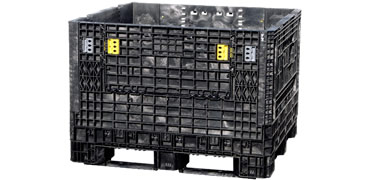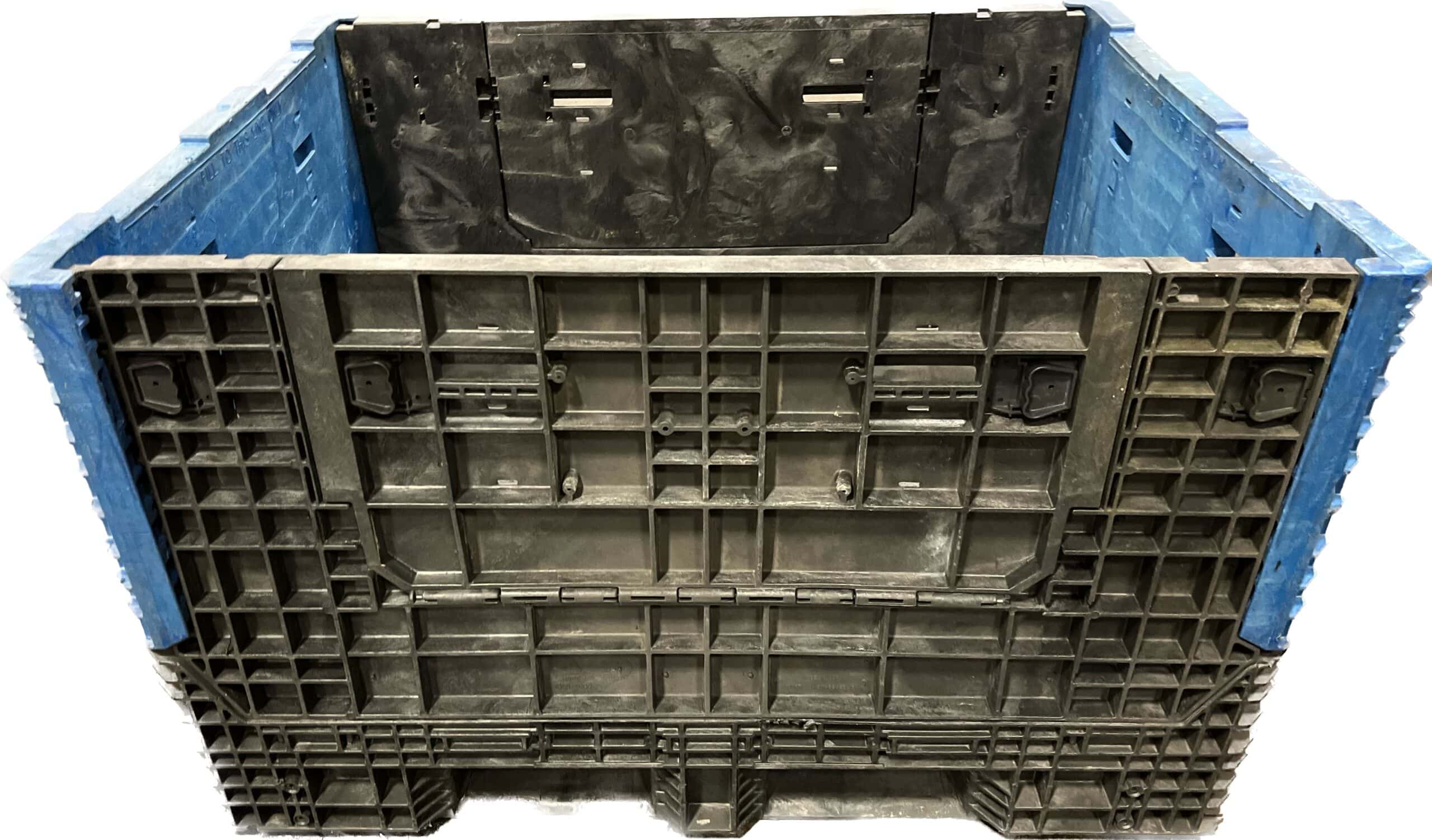The Ultimate Guide to Choosing the Right Bulk Containers for Your Organization Needs
Picking the appropriate mass containers is crucial for any kind of service that relies upon effective logistics. Various sorts of containers exist, each designed for particular products and applications. Elements such as dimension, product compatibility, and governing standards play a significant role in this decision-making procedure. Recognizing these components can cause enhanced functional efficiency. Nevertheless, lots of services neglect important facets that might improve their general efficiency and sustainability. What are these considerations?
Comprehending Different Kinds of Mass Containers
Bulk containers act as necessary tools for services seeking efficient storage space and transport services. These containers come in various types, each made to fulfill specific functional requirements. One usual kind is the intermediate mass container (IBC), which is excellent for granulated and liquid products, using a balance of capacity and ability to move. An additional popular alternative is the bulk bag, or FIBC, appropriate for dry, flowable items. These adaptable containers are lightweight and can be quickly moved and saved. For heavier products, stiff bulk containers are frequently utilized, providing longevity and stability for safe handling. Additionally, there are customized containers customized for dangerous materials, making certain compliance with security guidelines. Comprehending the distinct features of these mass container types permits organizations to make informed choices that maximize logistics and reduce expenses. By selecting the right container, business can enhance their operational effectiveness and enhance their supply chain procedures.
Key Material Considerations for Bulk Containers
When picking bulk containers, it is essential to consider the materials made use of in their construction. Factors such as sturdiness, toughness, and chemical compatibility play an important duty in making sure the containers satisfy details operational demands. Additionally, weight and transportability problems can impact both performance and transportation logistics.
Material Longevity and Strength
Toughness and toughness are vital consider selecting materials for mass containers, as they directly affect the container's ability to stand up to various environmental conditions and dealing with processes. Materials such as high-density polyethylene (HDPE), polypropylene, and stainless steel are generally preferred for their robust buildings, providing resistance to abrasion, effect, and temperature variations. The selection of material additionally affects the overall life expectancy of the container; stronger products normally lead to much less constant substitutes, bring about cost savings over time. Furthermore, the weight of the material can impact shipping costs and ease of handling. Businesses must consider their specific functional atmospheres and the possibility for damage to assure peak durability and toughness in their mass container choice.
Chemical Compatibility Factors
Recognizing chemical compatibility is important for selecting bulk containers, as the materials used need to stand up to the particular materials they will hold. Numerous aspects influence compatibility, including the chemical nature of the components, temperature level, and period of storage. Harsh chemicals may need containers made from stainless steel or specialized plastics that resist destruction. In addition, reactive materials can create warm or gases, necessitating aired vent or pressure-rated containers. The choice of container material, whether polyethylene, steel, or polycarbonate, need to line up with the chemical properties of the kept compounds to stop breaches or leakages. Inevitably, a detailed analysis of these compatibility variables ensures safe handling and storage, securing both personnel and the atmosphere while keeping product stability.
Weight and Transportability Issues
Picking mass containers involves not just reviewing chemical compatibility yet likewise taking into consideration weight and mobility. Services must evaluate the simplicity of handling and transport to optimize efficiency. Lightweight materials like high-density polyethylene (HDPE) or light weight aluminum can help with easier motion and lower delivery prices. Conversely, heavier containers might give boosted toughness but can prevent wheelchair, particularly in atmospheres calling for frequent moving. Additionally, the design of the container need to permit for hassle-free lifting and stacking, guaranteeing ergonomic security for employees. Companies need to additionally think about the facilities readily available for transportation; as an example, containers compatible with forklifts or pallet jacks can simplify procedures. Eventually, the best equilibrium in between weight and transportability straight influences functional performance and price effectiveness.
Sizing Your Mass Containers for Optimum Effectiveness
When sizing mass containers, services must thoroughly examine the measurements needed to suit their particular items. In addition, weight capacity is an essential factor that influences performance and safety during transport and storage. Reliable sizing not just makes best use of room yet additionally optimizes functional process.
Identifying Container Capacities
Selecting the appropriate measurements for mass containers is essential for optimizing effectiveness in storage and transport. Services have to assess their specific demands, taking into consideration factors such as available area, the nature of the goods being kept, and the techniques of transportation made use of. Accurate dimensions guarantee that containers fit preferably in stockrooms and vehicles, decreasing lost area and lowering handling time. Standard sizes can offer benefit, however custom measurements could be required for distinct requirements or to accommodate specific products. Furthermore, it is essential to evaluate piling abilities and access, as these aspects influence general functional effectiveness. Eventually, the appropriate measurements bring about improved organization and streamlined logistics, benefiting the overall productivity of the company.
Weight Capacity Considerations
Recognizing weight ability is important for businesses aiming to optimize their mass container efficiency. The weight capability of a container directly affects storage capabilities, transport logistics, and total functional expenses. Selecting containers with the appropriate weight limits ensures that organizations can safely save and carry their products without running the risk of damages or compliance problems. Overwhelming containers can result in structural failings, while underutilizing ability cause squandered sources. It is very important for companies to evaluate their product weights and think about any regulative requirements when selecting containers. In addition, factors such as the type of material, more info planned use, and environmental conditions need to also affect weight capability decisions. By evaluating these aspects, companies can improve performance and ensure a streamlined supply chain.
Governing Compliance and Security Requirements

Governing compliance and security standards play a vital duty in the selection of mass containers for organizations. Organizations must ensure that their containers satisfy numerous regulations established by local, national, and international authorities. These standards often pertain to material security, structural integrity, and correct labeling, which aid prevent crashes and assure the safe transport of items.
Additionally, adherence to industry-specific guidelines, such as those from the Food and Medicine Administration (FDA) or the Occupational Safety And Security and Wellness Administration (OSHA), is critical for firms handling dangerous materials or food items. Non-compliance can result in penalties, lawful concerns, or damage to a service's track record.
Services must additionally consider the container's compatibility with the products being saved or moved to avoid contamination or chain reaction (used collapsible bulk containers). To summarize, understanding and applying regulative conformity and security criteria is vital for the effective and liable use of bulk containers
Sustainability Options for Eco-Friendly Bulk Containers

Firms are also discovering options made from recycled products, which not only conserve resources but also support the reusing industry. Innovations in style permit for lighter containers that need much less energy to transportation, further enhancing sustainability. By integrating these eco-friendly bulk container options, businesses can show their dedication to ecological stewardship while satisfying customer demand for lasting practices. This shift not just helps the planet yet can also improve brand online reputation and customer loyalty.
Cost-Effectiveness and Budgeting for Bulk Containers
While numerous businesses focus on sustainability, cost-effectiveness continues to be a critical factor when choosing bulk containers. Organizations needs to analyze the initial acquisition cost, in addition to long-lasting functional expenses, to guarantee monetary stability. Elements such as upkeep, toughness, and reusability play a considerable role in identifying general costs.
Buying high-grade containers may produce greater in advance prices yet can bring about cost savings through decreased replacement rates and decreased waste. Furthermore, services need to take into consideration transport prices and storage space performance, as these can influence the overall budget plan.

Often Asked Questions
Just how Do I Identify the Right Container for Hazardous Products?
To determine the appropriate container for harmful products, one must evaluate compatibility with the material, consider the container's material, look for governing conformity, and assess ability and security functions to ensure appropriate handling and storage.
Can Mass Containers Be Personalized for Particular Products?
Yes, bulk containers can be tailored for particular products. used bulk containers. Various attributes, such as style, size, and product, can be tailored to fulfill distinct needs, ensuring excellent safety and security and efficiency for carrying and keeping various goods
What Is the Ordinary Lifespan of Different Mass Container Kind?
The typical life-span of mass container kinds varies; plastic containers last 5-10 years, metal containers 10-20 years, and wooden containers usually last 3-7 years, relying on use, maintenance, and ecological conditions.
Just how Should I Tidy and Maintain Bulk Containers?
To clean and maintain bulk containers, one must frequently examine for damages, get rid of deposit, clean with suitable cleaning agents, wash extensively, and guarantee appropriate drying out prior to storage space. Complying with supplier standards improves long life and safety throughout use.
Exist Rental Options for Mass Containers Available?
Yes, countless business supply rental alternatives for bulk containers, offering flexibility for companies. These leasings can fit numerous requirements, allowing companies to handle supply effectively without the commitment of buying containers outright.
Longevity and strength are essential variables in selecting products for bulk containers, as they straight influence the container's capability to endure various ecological problems and handling procedures. Understanding chemical compatibility is essential for selecting bulk containers, as the materials used have to withstand the particular materials they will certainly hold. Recognizing weight capability is important for businesses aiming to maximize their bulk container effectiveness. Regulative compliance and safety requirements play a vital function in the selection of mass containers for services. While several services concentrate on sustainability, cost-effectiveness remains a vital aspect when selecting bulk containers.